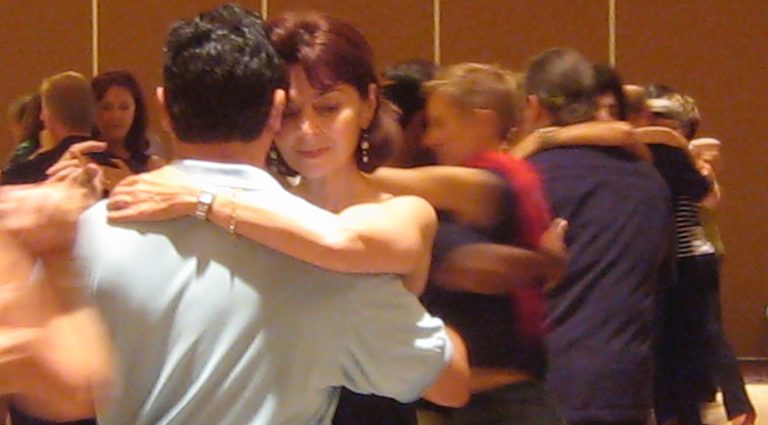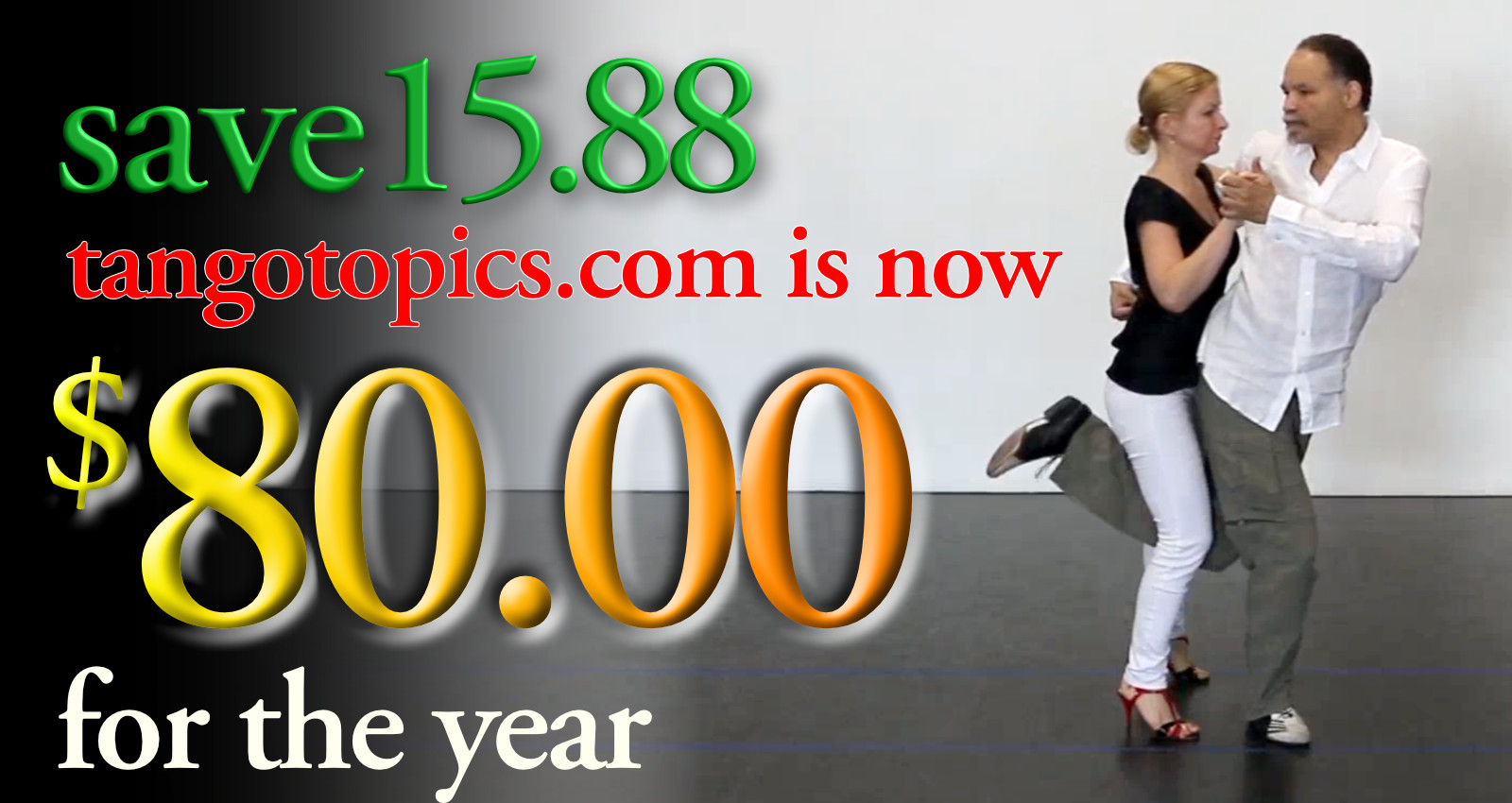Tango Festival. A Festival is a series of Tango related events that happen over a 4 to 5 day period of time, starting on a Thursday and ending on a Sunday night. The events range from Tango performances, tango practicas, and Milongas (of course), to tango workshops, selling and trying on tango shoes and tango clothing. Everything and anything related to tango are welcomed at a Tango Festival. Hence the word, ‘festival’. It’s a celebration of everything that is related to Tango.
Food/Lodging. Unlike Tango Marathons or Private Parties, that may provide a culinary experience, you’ll have to go get your own by finding a local restaurant or by premaking food before you leave for the daily festivities. While the Festival organizers will provide juices, water, coffee, tea, and sometimes alcohol (for sale), they only provide light ‘snacks’. Very light. Fruit, nuts, potato chips, and of course chocolate, that sort of thing. Mostly however if you want food you’ll have to go get. As far as lodging goes, typically the Festival is either in a hotel with a ballroom and the organizer has an arrangement with the hotel to give discounts on lodging. Hostels are a good way to save money for lodging instead of the special rate that an organizer has gotten, especially in europe… 🙂 Usually the special rate is about 10 to 20% off the hotel’s listed fees which is sometimes not a deal. A hostel may provide actually better service (fee wise) and sometimes have a better rate for a private room, or a shared room than a hotel does. YMMV.
Classes/Workshops. Typically there are workshops at these events. And there is a need for them. Most often the Festival is the only way that a local or regional dancer will get access to a visiting teacher or couple that they’ve seen performing at other festivals via YouTube. Workshops are generally 1.5 hrs in length, with course descriptions online before the Festival actually happens. Workshops range in prices from 25 to 45 (dollars/euros) per with package rates being offered by the organizers ahead of time. So it is advantageous to take a bunch of classes, price-wise, to seemingly get a whole bunch of tango information all at once. Workshops at these events are usually very populated, crowded so it is very helpful for you to bring your own partner that you have studied with as there are times when you may be asked to rotate partners which can be helpful sometimes, and sometimes not. Workshops range in topics from Sacadas, Colgadas, Boleos, Ganchos, to Floorcraft, Follower’s Technique, to how to dance to a specific orchestra.
Performances/Shows. At some point during the Nightly Milonga, the organizer will stop the dancing, and showcase a particular teaching couple for a 3 to 6 song performance. Usually this is done as a way to show you what this couple can do or to introduce you to that couple if you’ve never seen them before. The performances are sometimes social dance performances, but more often than not choreographies that resemble social dance ideas. Meaning ? These are ideas, that when you take them out of their context of what would happen at a Milonga, in the line of dance, and if taken to the extremes, or to their logical conclusions, you might…if there were space for these sort of things, and if you had the skills necessary, that you may … given time, study, patience, and lots of practice actually be able to pull off some of what you see a couple demonstrating. The performance is designed to do 2 things: 1.) Show off the couple. 2.) Get you to study with them. What you’re looking at is not by any stretch of the imagination a Social Dance Performance (very rare) it’s about showing off, tricks, flashy moves, exhaulting someone skillset that they’ve worked long and hard on to put into their dance to show you what you could do if the conditions were there for those skills to be shown off. Usually a performance is just that. They should not be taken as gospel as to what one should dance like at a Milonga, ever.
Live Music/DJs. Sometimes there are Tango Orchestras or quartets that are invited to play a live tanda or three but usually the music is all DJ’d by a local or regionally known DJs. The DJs in this instance will emulate the Marathon environment by putting together the 443 tanda idea. The number 443 refers to the number of songs in a Tanda and the type of Tanda. 4 Tangos, 4 Valses, and 3 Milongas. The Festival environment is really about showcasing different ideas or styles and genres of danceable tango music. ‘Danceable’ being the operative word. You may have Golden-Age (music from 1928 – 1953), Chacarera, Zamba, Piazzolla, Late Pugliese, Late Biagi, Later Troilo, with an Alternative (modern music where tango can be danced to) tanda or two mixed in to make everyone happy.
Getting In. Registration is open. There is no competition to get into a Tango Festival, because this is about getting warm bodies in the door. There are no pre-requisites to getting in. You can typically show up the day of the Festival and ‘register’ to get in. There are absolutely no pre-registrations. Go. However, showing up at the door the day of, and expecting the fees to be cheap, you’re taking your wallet into your own hands and literally handing it to someone. It’s not going to be cheap. That’s why it’s best to ‘Early-Bird’ or Pre-Register ahead of time. Don’t say you weren’t warned.
Gender Balancing. Gender balancing is a way to to ensure that when people register that there are an equal number of men and equal number of women to dance with. Gender balancing as a practice only addresses the numbers of people in the room, not the quality of dance of those people in the room, nor their desirability to dance with X, Y, or Z. There is no gender balancing at Tango Festivals. Nor is there any need to like a Tango Marathon, or an Encuentro. The event is open so there may be a gender imblance with the Row of Women that sit, and the Row of Men that stand.
Style of Dance. The style of dance at these events could loosely be construed as ‘Open Salon’. There will be Close Embrace dancing where there may be Boleos, Ganchos, Volcadas, or Colgadas that take up space in the line and lane of dance. Lane and Line of dance may be respected, but generally is not. Mostly the Male Cabeceo is not respected, and line of dance is very … ahem … ‘fluid’. There is a semblence of a Ronda, but it’s generally like a zoo. Don’t expect nice lines of dance like an Encuentro. It’s just not going to happen.


